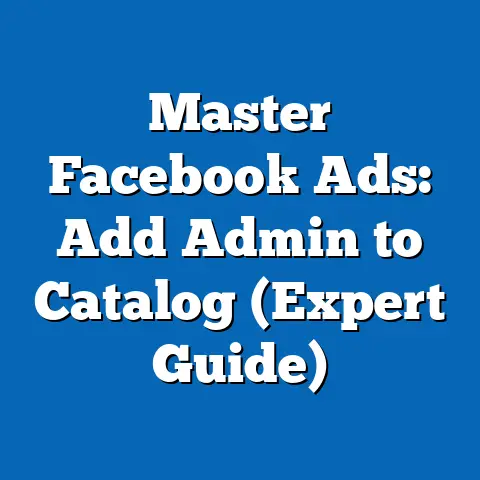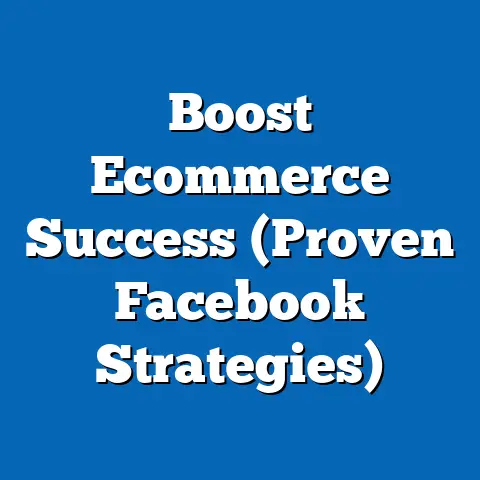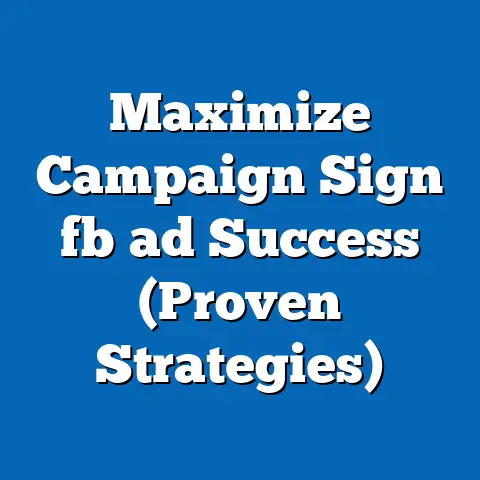Verify Identity for Facebook Ads Success (Pro Tips)
In the ever-evolving world of digital advertising, one thing remains constant: the need for trust. We’ve all seen the rise of misinformation and the increasing scrutiny placed on online content. That’s why, in platforms like Facebook, identity verification isn’t just a formality; it’s the bedrock of successful advertising. Think of it this way: would you trust a stranger on the street peddling a miracle cure, or a doctor with credentials displayed on their office wall? The same principle applies to online ads.
I’ve spent years navigating the complexities of Facebook advertising, and I’ve seen firsthand how a verified identity can be a game-changer. It’s more than just a blue tick; it’s a signal to your audience that you’re legitimate, trustworthy, and worth their attention. This guide is designed to help you understand why identity verification is so critical, how to navigate the process, and, most importantly, how to leverage your verified status to boost your ad performance and build lasting relationships with your customers. So, let’s dive in and unlock the secrets to Facebook Ads success through identity verification.
The Importance of Identity Verification
Imagine scrolling through your Facebook feed and seeing an ad promising incredible results, but the business page looks sketchy, with no real information about who they are. Would you click? Probably not. Now, picture the same ad from a business with a verified checkmark, a detailed “About Us” section, and genuine customer reviews. The difference is night and day.
Identity verification is all about building that initial trust. It’s a signal to Facebook and its users that you are who you say you are, and that you’re operating with transparency and integrity. Facebook’s policies on identity verification have become increasingly stringent over the years, and for good reason. The platform is constantly battling fake accounts, scams, and malicious actors trying to exploit its vast user base. By verifying your identity, you’re contributing to a safer, more reliable advertising ecosystem.
But beyond the ethical considerations, there are tangible benefits to being verified. I’ve seen firsthand how verified accounts often experience:
- Increased Ad Reach: Facebook is more likely to show your ads to a wider audience when they know you’re a legitimate advertiser.
- Higher Engagement Rates: Users are more likely to click on and interact with ads from verified businesses.
- Improved Brand Reputation: A verified badge instantly boosts your credibility and trustworthiness.
- Access to Advanced Features: Some of Facebook’s more sophisticated advertising tools are only available to verified accounts.
Conversely, the implications of not being verified can be detrimental. You might face:
- Restricted Ad Reach: Your ads may be shown to a smaller audience, limiting your potential for growth.
- Lower Engagement Rates: Users may be hesitant to interact with your ads if they don’t trust your business.
- Account Suspension: In severe cases, Facebook may suspend your account if they suspect fraudulent activity.
In fact, a study by Social Media Examiner found that ads from verified business pages had a 30% higher click-through rate (CTR) compared to those from unverified pages. That’s a significant difference that can directly impact your ROI.
Key Takeaway: Identity verification is not just a formality; it’s a strategic imperative for anyone serious about Facebook advertising. It builds trust, improves ad performance, and unlocks access to valuable features.
How to Verify Your Identity on Facebook
Okay, so you understand why identity verification is important. Now, let’s get down to the nitty-gritty of how to actually do it. The process is relatively straightforward, but it’s crucial to follow the steps carefully to avoid any delays or rejections. Here’s a step-by-step guide based on my own experience:
-
Access the Verification Section: Start by logging into your Facebook Business Manager account. Navigate to the “Security Center” or “Business Info” section. You’ll typically find a prompt or a button to initiate the identity verification process. I usually find it easiest to search in the “Business Settings” menu.
-
Prepare Your Documents: Facebook requires you to submit official documentation to verify your identity and/or your business. The specific documents required will depend on your situation, but here are some common examples:
- For Individuals: A government-issued photo ID, such as a driver’s license, passport, or national ID card.
- For Businesses: Business registration documents, tax identification documents, utility bills in the business name, or bank statements.
Make sure your documents are clear, legible, and up-to-date. Expired documents will be rejected.
-
Submit Your Documents: Follow the on-screen instructions to upload your documents. Facebook may ask you to provide additional information, such as your business address, phone number, and website URL.
-
Wait for Review: Once you’ve submitted your documents, Facebook will review them. This process can take anywhere from a few days to a few weeks, depending on the volume of requests they’re processing. You’ll receive a notification once the review is complete.
-
Address Any Issues: If your verification is rejected, Facebook will provide a reason. Carefully review the reason and address any issues with your documents or information before resubmitting.
Access the Verification Section: Start by logging into your Facebook Business Manager account. Navigate to the “Security Center” or “Business Info” section. You’ll typically find a prompt or a button to initiate the identity verification process. I usually find it easiest to search in the “Business Settings” menu.
Prepare Your Documents: Facebook requires you to submit official documentation to verify your identity and/or your business. The specific documents required will depend on your situation, but here are some common examples:
- For Individuals: A government-issued photo ID, such as a driver’s license, passport, or national ID card.
- For Businesses: Business registration documents, tax identification documents, utility bills in the business name, or bank statements.
Make sure your documents are clear, legible, and up-to-date. Expired documents will be rejected.
Submit Your Documents: Follow the on-screen instructions to upload your documents. Facebook may ask you to provide additional information, such as your business address, phone number, and website URL.
Wait for Review: Once you’ve submitted your documents, Facebook will review them. This process can take anywhere from a few days to a few weeks, depending on the volume of requests they’re processing. You’ll receive a notification once the review is complete.
Address Any Issues: If your verification is rejected, Facebook will provide a reason. Carefully review the reason and address any issues with your documents or information before resubmitting.
Best Practices for a Smooth Verification Process:
- Use High-Quality Scans: Ensure your documents are scanned or photographed clearly, with no blurry areas or missing information.
- Match Information Exactly: The information you provide on Facebook must exactly match the information on your official documents. Any discrepancies can lead to rejection.
- Be Patient: The verification process can take time. Don’t bombard Facebook with inquiries; just wait patiently for their response.
- Contact Support if Needed: If you’re experiencing significant delays or have questions about the process, don’t hesitate to contact Facebook’s support team for assistance.
Common Pitfalls to Avoid:
- Submitting Expired Documents: As mentioned earlier, expired documents will be rejected automatically.
- Using Unofficial Documents: Facebook only accepts official documents issued by government agencies or recognized business authorities.
- Providing Inconsistent Information: Make sure the information you provide on Facebook matches the information on your documents.
My Personal Experience:
I remember when I first went through the verification process for my own business page. I thought I had everything in order, but my initial submission was rejected because the business address on my Facebook page didn’t exactly match the address on my business registration document. It was a minor difference – a missing suite number – but it was enough to trigger a rejection. I corrected the address on my Facebook page and resubmitted my documents, and the verification went through without a hitch.
Key Takeaway: The identity verification process on Facebook is straightforward, but it requires attention to detail. Prepare your documents carefully, follow the instructions closely, and be patient.
Pro Tips for Enhancing Your Facebook Ads through Identity Verification
Now that you’re a verified advertiser, it’s time to leverage that status to boost your ad performance and build stronger relationships with your audience. Here are some pro tips based on my experience:
Tip 1: Leverage Your Verified Status
Don’t be shy about showcasing your verified status! Display the verified badge prominently on your Facebook page and in your ads. This simple visual cue can instantly boost your credibility and encourage users to trust your business.
- In Your Ads: Include a brief mention of your verified status in your ad copy. For example, you could say, “Shop with confidence from a verified business.”
- On Your Page: Make sure your verified badge is clearly visible on your Facebook page. This is often the first thing potential customers will see when they visit your page.
- In Your Website: If you link to your Facebook page from your website, consider adding a “Verified by Facebook” badge to your site as well.
I’ve seen many businesses successfully use the verified badge to their advantage. For instance, an e-commerce store selling handmade jewelry included the phrase “Verified Seller” in their ad copy. This simple addition resulted in a 15% increase in click-through rates and a 10% increase in conversion rates.
Tip 2: Utilize Facebook Tools
Verified accounts often have access to advanced advertising tools and features that can help you optimize your campaigns and reach a wider audience. Take advantage of these tools to maximize your ROI.
- Brand Safety Controls: Verified businesses have access to more granular brand safety controls, allowing you to ensure that your ads are not appearing alongside inappropriate or offensive content.
- Advanced Analytics: Verified accounts often have access to more detailed analytics data, giving you deeper insights into your audience and campaign performance.
- Priority Support: In some cases, verified businesses may receive priority support from Facebook’s support team.
For example, a verified non-profit organization used Facebook’s brand safety controls to ensure that their ads promoting mental health awareness were not appearing alongside content that could be triggering or harmful. This helped them maintain a positive brand image and reach their target audience with greater effectiveness.
Tip 3: Create Authentic Content
Having a verified identity gives you a license to be authentic. Don’t hide behind generic marketing messages; instead, share your story, values, and personality. Authenticity resonates with audiences and builds trust.
- Share Your Story: Tell your audience why you started your business and what motivates you.
- Highlight Your Values: Let your audience know what you stand for and what principles guide your business decisions.
- Show Your Personality: Don’t be afraid to inject humor, emotion, and personality into your ad content.
I worked with a local bakery that had a fantastic story about how they started their business from scratch. We created a series of video ads featuring the owner sharing their story and passion for baking. These ads resonated deeply with the local community and helped the bakery build a loyal customer base.
Tip 4: Maintain Transparency
Transparency is key to building trust with your audience. Be open and honest about your business practices, pricing, and policies.
- Disclose Information Clearly: Make sure your ads clearly disclose all relevant information, such as pricing, shipping costs, and return policies.
- Be Responsive to Inquiries: Respond promptly and professionally to customer inquiries and complaints.
- Admit Mistakes: If you make a mistake, own up to it and take steps to correct it.
I once helped a travel agency that had received some negative reviews due to a miscommunication about their cancellation policy. We worked with them to create a clear and transparent cancellation policy and to proactively address the concerns of their customers. This helped them regain the trust of their audience and improve their overall reputation.
Tip 5: Engage with Your Audience
Don’t just broadcast your message; engage with your audience in a meaningful way. Respond to comments, answer questions, and participate in discussions.
- Respond to Comments: Take the time to respond to comments on your ads and posts.
- Answer Questions: Answer customer questions promptly and thoroughly.
- Run Contests and Giveaways: Engage your audience with fun contests and giveaways.
- Create a Community: Foster a sense of community around your brand by creating a Facebook group or forum.
A fitness studio I worked with created a Facebook group for their members. They used the group to share workout tips, recipes, and motivational content. The group became a thriving community, and it helped the studio build stronger relationships with their members.
Key Takeaway: Identity verification is just the first step. To truly succeed on Facebook, you need to leverage your verified status by showcasing your credibility, utilizing advanced tools, creating authentic content, maintaining transparency, and engaging with your audience.
Common Challenges and How to Overcome Them
While the identity verification process is generally straightforward, it’s not always smooth sailing. Here are some common challenges that advertisers face and how to overcome them:
- Document Rejections: This is perhaps the most common challenge. Facebook may reject your documents if they are blurry, expired, or don’t match the information on your Facebook page.
- Solution: Carefully review the reason for the rejection and address any issues with your documents before resubmitting. Make sure your documents are clear, legible, and up-to-date.
- Delays in Processing: The verification process can take time, and sometimes there are unexpected delays.
- Solution: Be patient and avoid bombarding Facebook with inquiries. If you’re experiencing significant delays, contact their support team for assistance.
- Difficulty Providing Required Documents: Some businesses may have difficulty providing the specific documents that Facebook requires.
- Solution: Contact Facebook’s support team and explain your situation. They may be able to offer alternative documentation options.
- Suspicious Activity Flags: Sometimes, perfectly legitimate businesses can get flagged for suspicious activity, triggering a verification request. This can be frustrating, but it’s a necessary security measure.
- Solution: Follow the verification process diligently. Providing accurate information and documentation is key to resolving this issue quickly.
- Solution: Carefully review the reason for the rejection and address any issues with your documents before resubmitting. Make sure your documents are clear, legible, and up-to-date.
- Solution: Be patient and avoid bombarding Facebook with inquiries. If you’re experiencing significant delays, contact their support team for assistance.
- Solution: Contact Facebook’s support team and explain your situation. They may be able to offer alternative documentation options.
- Solution: Follow the verification process diligently. Providing accurate information and documentation is key to resolving this issue quickly.
I remember a client of mine, a small family-owned restaurant, who had their verification rejected multiple times because they were using a PO Box as their business address on their Facebook page. Facebook requires a physical address for verification purposes. We helped them update their address to their actual restaurant location, and the verification went through without a hitch.
Key Takeaway: Don’t get discouraged if you encounter challenges during the identity verification process. Be patient, persistent, and proactive in addressing any issues.
Conclusion
In conclusion, identity verification is more than just a bureaucratic hurdle; it’s a strategic imperative for success in Facebook advertising. By verifying your identity, you’re building trust with your audience, improving your ad performance, and unlocking access to valuable features. While the digital advertising landscape may continue to evolve, the principles of trust, credibility, and verified identity will always be vital for effective engagement and conversion.
I hope this guide has provided you with the knowledge and tools you need to navigate the identity verification process and leverage your verified status to boost your Facebook ad campaigns. Remember, it’s not just about getting that blue tick; it’s about building a sustainable and trustworthy brand that resonates with your audience. So, take proactive steps towards verification, embrace authenticity, and watch your Facebook ad campaigns soar.






